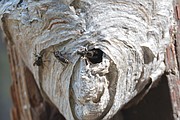Bald-faced hornets preparing for fall
“I may think that hornets do not have an ideal social organization. But I know better than to poke their nest.” — Fred Reed
This past weekend I was traveling along U.S. Forest Service Road 2491 in the Idaho Panhandle National Forest, about 10 miles north of “three mile corner,” when I came onto Road 2499. I glanced at the intersection sign as I passed it and out of the corner of my eye I saw something curious in-between the two signs on the same wooden post. I backed my Jeep up and found a grey shiny dome the size of a squished volleyball hanging between the two road signs.
I stopped to investigate knowing it was some kind of a wasp nest and to not get too close ... wasps need no introduction. I observed what appeared to be wasps busily going in and out of the bottom of the huge grey hive.
Taking pictures of the hive I became curious about the insects that were wasp-like but had a black and white appearance and were bigger than a yellow jacket. As I observed the hive with my telephoto lens I discovered that the wasps were actually bald-faced hornets, and the volleyball size hive was their home which they would viciously defend if threatened.
The bald-faced hornet belongs to the genus Dolichovespula. Bald-faced hornets are more closely related to yellow jackets than they are to hornets. The body of the bald-faced hornet is black in color, and its face is marked with white.
Bald-faced hornets are larger than most yellow jackets. These hornets have powerful stings and need little introduction to most people. The bald-faced hornet lives in North American, including Canada, the Rocky Mountains, the western coast of the United States and eastern United States.
The bald-faced hornet gets its name from the characteristic white markings on its face, as the word “bald” in English is derived from the word piebald (irregular patches of two colors, typically black and white). These hornets are distinguished from other yellow jackets by their white and black coloring. It has a white or “bald-faced” head, which is the source of its colloquial namesake. These wasps also have three white stripes at the end of their bodies.
Bald-faced hornets are most active during the day. They usually build aerial nests made of paper-like materials in trees or under overhangs. Adults consume liquids, usually sugars like juices or nectar, but will bring back solids such as insects or carrion for the larvae to consume. Bald-faced hornets create this paper nest by collecting and chewing naturally occurring fibers. The wood fiber mixes with their saliva to become a pulpy substance that they can then form into place.
Bald-faced hornets are omnivorous, and are considered to be beneficial due to their predation of flies, caterpillars, and spiders. However, their aggressively defensive nature makes them a threat to humans who wander too close to a nest or when a nest is constructed too close to human habitation. They vigorously defend the nest, with workers stinging repeatedly, as is common among social bees and wasps. However, the bald-faced hornet has a unique defense in that it can squirt venom from the stinger into the eyes of vertebrate nest intruders. The venom causes immediate watering of the eyes and temporary blindness.
Queen hornets begin the construction of hornet nests in order to house their eggs. The queen lays one egg within a cell and builds her way out, constructing a comb. Nests are built tier after tier. The eggs hatch into larvae. The larvae develop into sterile adult females. These female workers then assume the responsibilities of nest building and brood tending, while the queen’s sole duty is to lay the eggs from which future generations are born in late summer. The queen will begin to produce male hornets, whose only purpose is to mate with queens. These fertilized females seek hiding places for the winter.
The size of a hornet nest grows in proportion to the size of the colony. Nests may grow to be as large as basketballs. As many as 700 workers may live in the nest. However, nests are only used once; worker populations perish in winter, leaving only the fertilized females to begin new colonies in the coming warm seasons.
Enjoy this fall and the beauty of Boundary County, but don’t poke a hornets’ nest!



